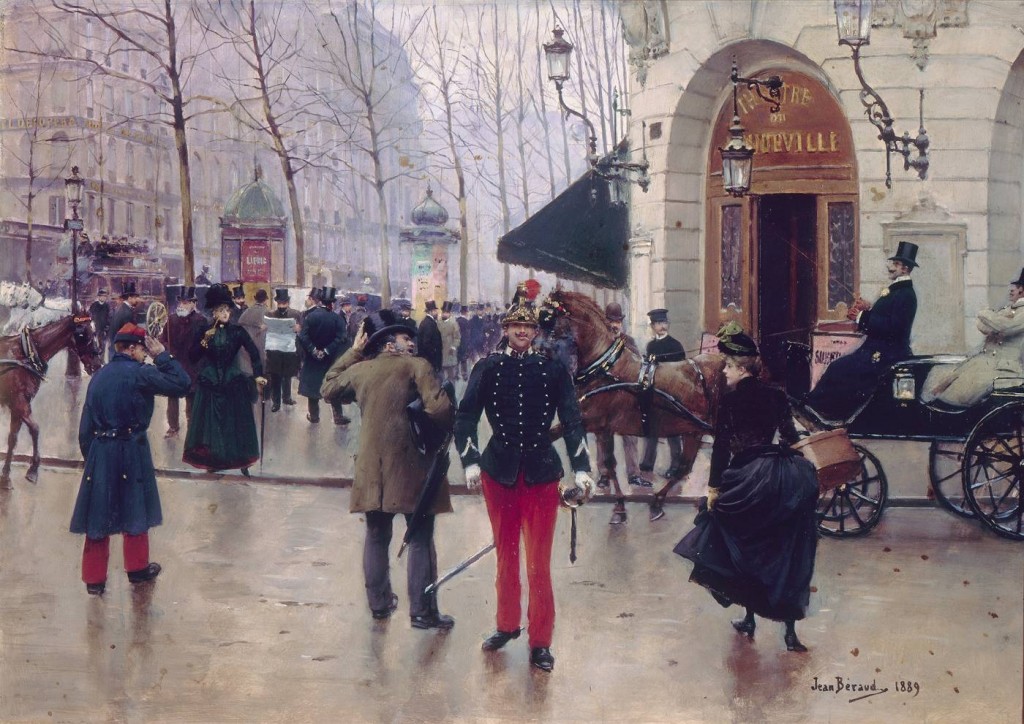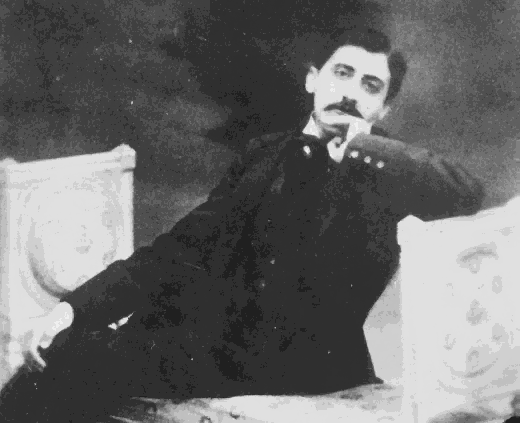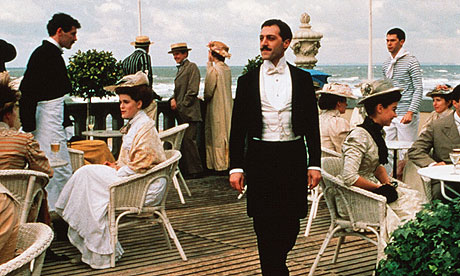Almost all of Marcel Proust’s novel ”Remembrance of Things Past” takes place in Paris. The presence of the city saturates the novel the way moisture saturates the air and determines its atmospheric pressure. There is likely no other city as present in a modern novel except for perhaps James Joyce’s Dublin. But unlike Joyce, who delivers Dublin in a single day, Proust makes Paris unfold over a period of roughly forty-five years, from 1875 to 1920. To read Proust is to observe the flowering and decline of a period in the capital’s history, for the debacle of 1870 and the horrors of the Commune were followed by years of determined amusement known as ”La Belle Epoque”. Those who had expected a wake found, instead, a celebration that was interrupted only by another war.

This view of the boulevard des Capucines, painted by Jean Beraud in 1889, provides a glimpse of the well-clad, fin-de-siecle Paris of which Proust was a part.
Proust was born in 1871 in a Paris already physically transformed by the Baron Haussmann, who destroyed entire neighborhoods to build long straight thoroughfares like the rue de Rivoli, who crossed the Seine with five new bridges, and who built the Halles central market. The transformation continued during Proust’s life. The avenue of the Opera linked the rue de Rivoli with Garnier’s opera house, inaugurated in 1874. The young Proust saw the Eiffel Tower go up, its four perforated iron legs rising from the green meadow of the Champs de Mars. In 1900 the Petit and Grand Palais were opened to the public. In the same year the first line of the metro was inaugurated, and the fanciful wrought iron entrances, with their orange lights and insect like appearance, contributed to what became known as the ”firefly” style of decoration.
And yet the capital of two and a half million people still resembled a collection of villages. The Champs Elysees remained unpaved until the twentieth century. The houses on the avenue du Bois, later avenue Foch, still had private stables. Public transportation consisted mainly of horse-drawn omnibuses, despite the Metro, which Proust mentions only once. Electric lighting was still a novelty, so that the narrator, going to Mme Swann, the mother of Gilberte, was guided by the light in her living room,which shone like a beacon in the dark. Houses, even those of the rich, were badly heated.
The traditional coexistence of luxury and discomfort was tempered by new inventions. Thus, the narrator acquires a telephone. As he waits for a call from Albertine, he remarks, ” The advance of civilization each of us to display unsuspected merits or fresh defects which make him dearer or more unsupportable to his friends. Thus Dr. Bell’s invention had enabled Francoise, his maid, to aquire an additional defect, which was that of refusing, however important, however urgent the occasion might be, to make use of the telephone.” She would manage to disappear whenever anybody was going to teach her how to use it, as people disappear when it is time for them to be vaccinated”.
This then was the city the narrator inhabited, not a mere setting, or a series of useful addresses, but a soyurce of daily nourishment for his senses. Its sounds reached him as he lay ill in his room. ” On certain fine days, the weather was so cold, one was in such full communication with the street, that it seemed as though a breach had been made in the outer walls of the house, and, whenever a tramcar passed, the sound of its bell throbbed like that of a silver knife striking a wall of glass.”
The street hawkers outside his window were ” an orchestra that returned every morning to charm me”. Their cries seemed like a recitative in an opera, ”where an initial intonation is barely altered by the inflexion of one note which rests upon another…” In counterpoint to the aristocracy which ”Remembrance” is mainly concerned, Proust shows us the little people of Paris, like the street vendors and the rouged lady called the ”Marquise” who operates the public toilet on the Champs Elysees. She says, ”And besides… I choose my customers, I don’t let everyone into my little parlours…” The instinct for social stratification, Proust shows us, exists at every level.

Marcel Proust was about twenty-five when this photograph was taken; a languid looking young writer and man about town.
Just as Proust’s Paris is more than a city, the Duc de Guermantes’s town house, where the narrator lives, is more than an address. It is the symbolic fortress of an inaccessible caste, for the Duc and Duchesse de Guermantes are the social leaders of Faubourg Saint-Germain, which is less a location than a state of mind. It is not limited to the fine old hou
clustered around the Boulevard Saint Germain. The Guermantes town house, for instance is on the other side of the river, on the right bank. It has everything to do with belonging to the ”ancien regime” aristocracy, still conscious of the privileges, still royalist, certain of its superiority and contemptuous of outsiders that makes it seem the custodian of a rare and desirable way of life, and to the rigid enforcement of a complicated social code.
The Baron de Charlus, the Duke de Guermantes’s younger brother, says, ” I know nothing outside of the Faubourg Saint-Germain.” Like the forbidden city of Peking, it is a closed, self contained, self sufficient society. Albertine, jealous of her finance’s Faubourg friends, whom she will never meet, says,” Of course, whoever comes from the Faubourg Saint-Germain possesses all the virtues”.
To the narrator, viwing it at first from afar, the Faubourg is a sublime enigma. He is incapable of imagining what it can be like, what these remote minor deities say to one another, what language they use. The guests arriving at the Duke de Guermantes’s house ” might have been made of some precious matter; they are columns that hold up the temple.” The narrator discovers, however, that the boundaries of the Faubourg are more flexible than he thought. A few outsiders are given ”naturalization papers” , little ways in which they know they have become accepted. Proust, like his narrator gained access to the reputably unapproachable world of the Faubourg because he was witty, kind, and solicitous, and above all because he passionately wanted to. It is hard to resist true passion. After having been it distant admirer, the narrator becomes the the chronicler of the Faubourg.
The focus of Proust’s Paris shifts, and centers on this tiny minority with an inflated sense of its own importance, absorbed in matters of rank and social exclusion, indifferent to the world outside its gates.









 COMMENTS
COMMENTS



